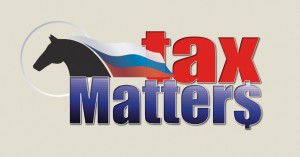Tax Matters – Deductions for Advertising & Promotional Expenses
Click here to read the complete article
160 – October, 2014
By John Alan Cohan, Attorney at Law
Advertising and promotional expenses are usually deductible along with other ordinary and necessary expenses in horse and livestock activities operated as a business. Traditional print ads in magazines can be expensive, and must be repeated in order to be effective. Other modes of advertising, such as on the internet or word-of-mouth advertising, as well as participation in horse shows, are important as well.
In some cases, a horse or livestock activity can be used to promote a separate business or professional activity. The idea is to link one’s separate business with the horse or livestock activity. Your business name will get exposure at various horse events, for instance, and this can be an effective way of reaching out to potential customers.
The most famous illustration of this is the Anhauser-Busch Company’s use of beautiful Clydesdale parade horses in Budweiser commercials and at horse shows. Another example was a Tax Court case in which the owner of a locksmith business claimed advertising deductions for his costs of maintaining Mardi Gras parade horses. He lost in Tax Court, however, because his business name was not even displayed on banners carried by his parade horses, and it was therefore hard to see how there was an advertising linkage to his business.
The classic case on this point is Rodgers Dairy Co. v. Commissioner (14 T.C. 66). Rodgers Dairy Company owned a chain of restaurants in Pittsburgh. The company purchased two Russian wolfhounds and kept them in a kennel at the rear of its headquarters, and claimed the costs as advertising deductions. The company claimed that the dogs attracted the attention of passersby, and enhanced the public image of the restaurant chain. The company also bought several show horses, also for advertising purposes.
The horses were always shown by professional trainers. The company made sure its logo and blue-and-white color scheme that it used on its storefronts and on trucks, were used in the decoration of the stables, equipment and vehicles at the horse shows. Signs were put in front of the stables disclosing that the company owned the horses; and horse show programs listed the company as owner of the horses. The horses won numerous ribbons and cups that were displayed on the walls of the company’s offices.
Some of the horses were later sold at substantial profits, and stud fees were collected as well. The company deducted the expenses of maintaining, training and transporting the horses, as well as depreciation, and the costs of the two Russian wolfhounds. The IRS argued that the company purchased the animals primarily for the personal pleasure of the company’s principal shareholder.
The company convinced the Tax Court that the sponsorship efforts helped attract new customers to its restaurant chain. The court ruled that the company acquired the animals for advertising purposes, that the costs involved were reasonable, and that the company was entitled to claim the costs as advertising deductions.
This type of advertising expense is unusual, but proper so long as there is some staightforward advertising linkage to your trade or profession. The IRS will seek to argue that these payments are motivated primarily as a way of funding your favorite pasttime.
It is also important to keep a record of new clients or contacts that were generated from the promotional efforts for one’s business or professional practice.
This type of advertising can be used in addition to more traditional advertising such as print ads, internet ads, and word-of-mouth efforts.
John Alan Cohan is an attorney who serves the horse, livestock and farming industries. He can be reached at: (310) 278-0203, or email at johnalancohan@aol.com. His website is JohnAlanCohan.com.











